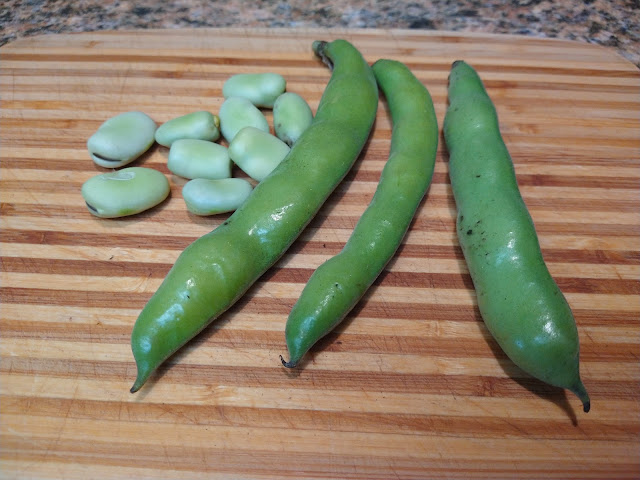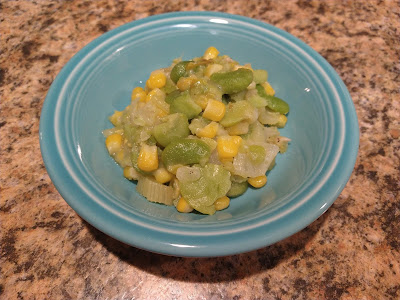
Recipe: Fava bean succotash with fresh corn
 |
| Favas have big pods and beans with chewy skins that are best removed. (Photos: Debbie Arrington) |
Succotash is a true American original. According to culinary lore, Native Americans introduced colonists to this mix of corn and beans – two crops that they grew (usually together). The name comes from an Algonquian word for “boiled corn kernels.”
In the late 1700s, New England recipes described succotash as “boiled corn and green beans especially limas.” Other vegetables were added to the flavorful mix and different beans substituted. Succotash evolved along with our country.
Favas work well as a substitute for limas, but these brightly colored (and meaty) beans cook in a fraction of the time. Although the peeled fava beans cook quickly, they take a while to prepare. After removal from their pods, large mature beans need to be individually skinned.
Those skins tend to be tough, chewy and bitter. Removal improves favas’ overall flavor and texture. Small, tender immature beans (under ¼ inch) can keep their skins on.
How to skin fava beans: Remove beans from pods. Bring a large pot of salted water to a boil. Plunge beans into boiling water and boil for 3 to 4 minutes, until the skins start to wrinkle.
Drain; plunge beans into ice water or rinse under cold water. With a thumb nail or paring knife, make a slit on long side of each bean and peel off skin, one at a time. Set aside the bright green fava beans.
Two cups unshelled fava beans yields about 1 to 1-1/4 cups peeled.
Fava beans also may be frozen for later use.
Fava bean succotash
Makes 4 servings
Ingredients:
1 cup fava beans, peeled
2 tablespoons butter
½ cup onions, chopped
½ cup celery, chopped including green tops
1 cup fresh corn kernels, cut from the cob
½ cup water
Salt and pepper to taste
Instructions:
Peel fava beans and set side.
In a heavy saucepan, melt butter. Saute onion and celery until soft.
Add corn kernels and water; bring to boil, then reduce heat to medium. Cover. Cook 4 minutes, until corn is almost tender.
Stir in fava beans gently. Add a little more water if necessary. Cover and cook over medium heat for 4 or 5 minutes, until beans are tender but not mushy.
Season with salt and pepper to taste. Serve immediately.
 |
| Fava bean succotash features fresh favas and corn. |
Comments
0 comments have been posted.Sacramento Digs Gardening to your inbox.
Sites We Like
Garden Checklist for week of May 5
Survey your garden after the May 4 rainstorm. Heavy rain and gusty winds can break the neck of large flowers such as roses. Also:
* Keep an eye on new transplants or seedlings; they could take a pounding from the rain.
* Watch out for powdery mildew. Warmth following moist conditions can cause this fungal disease to “bloom,” too. If you see a leaf that looks like it’s dusted with powdered sugar, snip it off.
* After the storm, start setting out tomato transplants, but wait on the peppers and eggplants (they want warmer nights). Pinch off any flowers on new transplants to make them concentrate on establishing roots instead of setting premature fruit.
* Trim dead flowers but not leaves from spring-flowering bulbs such as daffodils and tulips. Those leaves gather energy to create next year's flowers. Also, give the bulbs a fertilizer boost after bloom.
* Pinch chrysanthemums back to 12 inches for fall flowers. Cut old stems to the ground.
* Mulch around plants to conserve moisture and control weeds.
* From seed, plant beans, beets, cantaloupes, carrots, corn, cucumbers, melons, pumpkins, radishes and squash.
* Plant onion sets.
* In the flower garden, plant seeds for asters, cosmos, celosia, marigolds, salvia, sunflowers and zinnias. Transplant petunias, zinnias, geraniums and other summer bloomers.
* Plant perennials and dahlia tubers for summer bloom.
* Don’t wait; plant summer bulbs, such as gladiolus and tuberous begonias.
* Harvest cabbage, lettuce, peas and green onions.